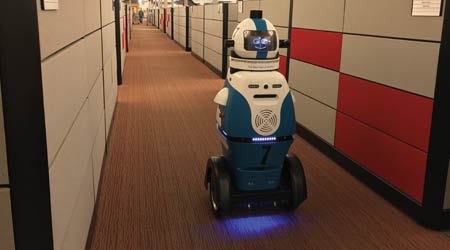 Security robots, such as Gamma 2 Robotics’ RAMSEE, can be used to augment an organization’s active surveillance efforts.Gamma 2 Robotics
Security robots, such as Gamma 2 Robotics’ RAMSEE, can be used to augment an organization’s active surveillance efforts.Gamma 2 RoboticsPhysical Security Meets Technological Innovation
From robots to drones, the gap between Hollywood and real-world security tech is closing rapidly. Here is the latest on what's new and cool in security technology.
Talk to physical security specialists and there’s one thing they want you to understand — that stuff you see on TV where they freeze a frame of surveillance video and zoom in down to the pores, that’s just not possible. Yet.
The gap between Hollywood and security technology in the real world is closing, though more slowly than some would like. In the realms of surveillance and video analytics, the security world is abuzz with advances in the capabilities of current technology. And the near future holds the promise of developments such as virtual command centers. Here is what facility managers can keep an eye on now as they consider tools to help augment their security team’s capabilities.
Robots and drones
When Mark Schreiber, president and principal consultant of Safeguards Consulting, talks about security robots, he prefers to use the term “unmanned ground vehicle” to more accurately reflect the capabilities of today’s technology. He currently sees a limited use case for security robots, which is tied to enhancing active surveillance efforts. Guard tours of a facility or campus can get to be monotonous work, where fatigue and boredom increase the chance for error. But a security robot could patrol the same space in a consistent manner, over and over.
Facility managers should keep any visions of Robocop well in check, however. “It will take some time to really get out the different nuggets of value,” says Schreiber. “It’s only the advanced high-tech organizations that are really going to start running with the ball initially.”
One early adopter of security robots is Microsoft, where the robot program at the company’s Redmond, Wash., headquarters has been successful enough that the technology will be spread to other Microsoft campuses. “Think about it more as a mobile sensor platform,” says Mike Anderson, security program manager, Microsoft global security. “That’s all it really is.” Sensors mounted on the robot can be deployed to detect any number of factors, from unregistered vehicles in a parking lot to unusual heat patterns in a data center. At Microsoft, some robots were deployed with an emergency communication call button, so an individual needing immediate assistance in a parking lot could run up and open a communication line with security, for example.
“The technology is still pretty young,” says Anderson. But he expects to see more robots patrolling places like malls or large corporate campuses in the next two to three years, “doing things that would enhance security operations, not replace them.”
Drones, or unmanned aerial systems, have a very different impact. “They’re a totally different type of platform for the same type of security sensors and technologies that we use in a fixed platform in many different locations,” says Schreiber. A surveillance camera on a fixed pole has a distinct value, primarily gathering forensic data. But put the camera on a drone and you now have a very fast mobile platform for active surveillance and emergency response.
On a large campus, a drone can be on site within minutes where a first responder could take much longer. “With a drone platform, we can get there in a fraction of the time, immediately get video and other sensors on that incident, and quickly evaluate what response is needed,” says Schreiber. All that without having to endanger a human life, as would be the case to evaluate a dangerous situation, like an explosion.
More than deploying a drone security team, Anderson says most companies are focused on developing an anti-drone plan. How can facility managers detect a drone on their campus? How can they detect where the signal is coming from, take over the drone, and land it? Anderson says facility managers should start by establishing the drone policy for their campus, and then worry about anti-drone defenses. For example, at Microsoft, the company’s own researchers on drones and robotics have to get security’s permission first to operate on campus. “They just want to fly their drone wherever they want, and you can’t have that,” Anderson says. “We had to establish a pretty strict policy.”
Related Topics:













